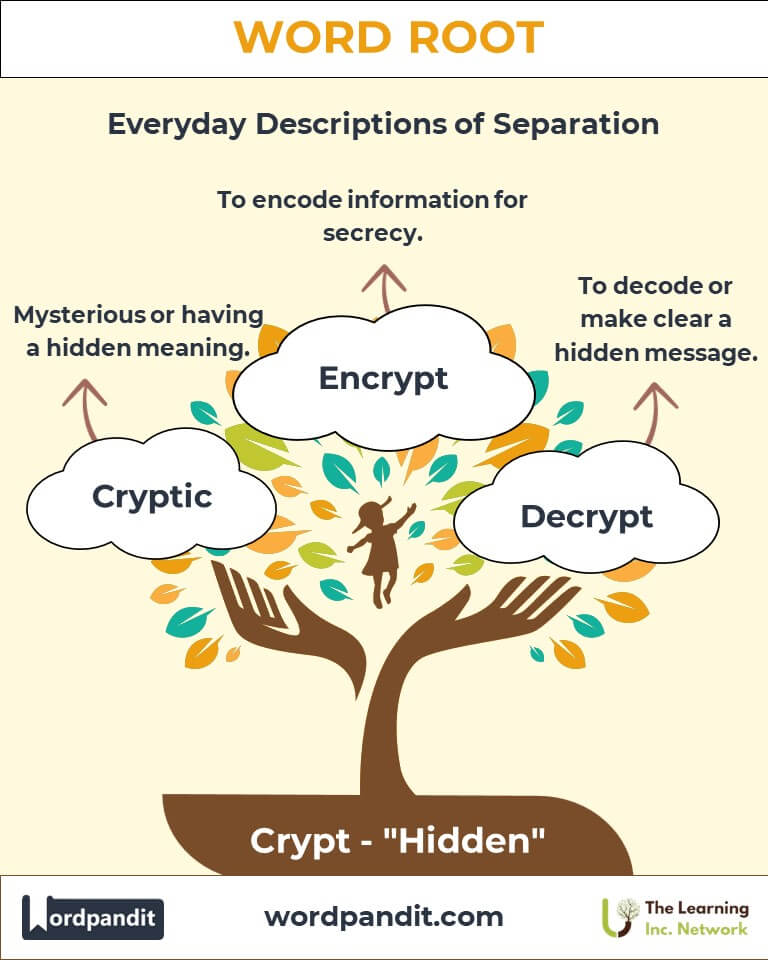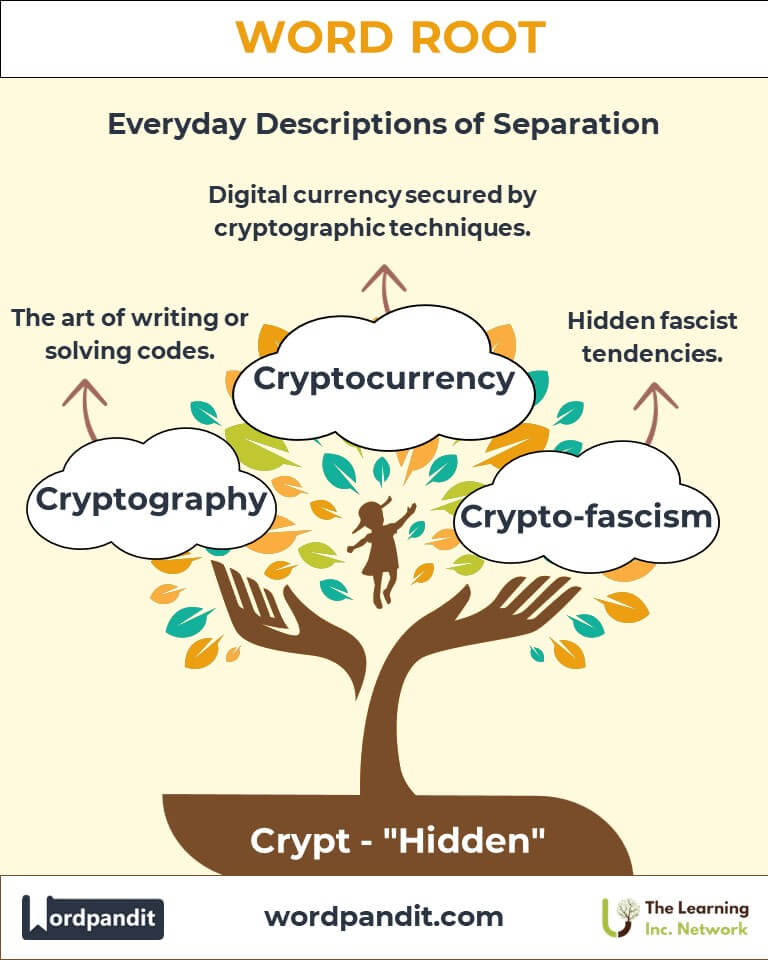Crypt: Unlocking the Secrets of the Hidden in Language and Beyond
Discover the fascinating world of the root "crypt," originating from the Greek word "kryptos," meaning hidden. From cryptography to cryptic, this root has profoundly influenced how we conceptualize mystery, secrecy, and concealment across languages and disciplines.

Table of Contents
- Introduction: The Essence of Crypt
- Etymology and Historical Journey
- Mnemonic: Unlocking the Power of Crypt
- Common Crypt-Related Terms
- Crypt Through Time
- Crypt in Specialized Fields
- Illustrative Story: Crypt in Action
- Cultural Significance of the Crypt Root
- The Crypt Family Tree
- FAQs about the Crypt Word Root
- Test Your Knowledge: Crypt Mastery Quiz
- Conclusion: The Unending Legacy of Crypt
1. Introduction: The Essence of Crypt
When you hear the word “crypt,” do you imagine a hidden vault or a mysterious code? The root "crypt" (pronounced kript) captures the essence of concealment and mystery. Derived from the Greek word kryptos, meaning hidden, this root has seeped into words describing secretive systems, enigmatic texts, and even physical spaces for safekeeping.
From ancient burial crypts to modern cryptography securing digital communication, "crypt" remains a cornerstone of intrigue and secrecy.

2. Etymology and Historical Journey
The root "crypt" traces back to ancient Greek, where kryptos was used to denote something concealed or private. It found its way into Latin as crypta, meaning a covered or hidden passage, often associated with underground chambers.
Over time, the term expanded into medieval and modern European languages, evolving into words like "cryptography" (the art of secret writing) and "cryptic" (mysterious or ambiguous). Its use in English solidified during the Renaissance, coinciding with the period’s fascination with secret knowledge and codes.
3. Mnemonic: Unlocking the Power of Crypt
To remember the meaning of "crypt," imagine a treasure chest hidden underground, accessible only with a secret map. The root "crypt" represents hidden treasures—whether they are physical, intellectual, or symbolic.
Mnemonic Device: "Crypt is the keeper of secrets, hiding treasures and truths alike."
4. Common Crypt-Related Terms
- Cryptography (krip-tog-ruh-fee): The art of writing or solving codes.
Example: "Modern cryptography ensures secure communication over the internet."
- Cryptic (krip-tik): Mysterious or having a hidden meaning.
Example: "Her cryptic reply left everyone guessing about her true intentions."
- Crypt (kript): An underground vault or chamber, often used for burial.
Example: "The ancient crypt held artifacts from a lost civilization."
- Decrypt (dee-kript): To decode or make clear a hidden message.
Example: "The detective decrypted the secret message to reveal the location."
- Encrypt (en-kript): To encode information for secrecy.
Example: "Emails are often encrypted to prevent unauthorized access."
5. Crypt Through Time
- Crypt (Ancient Usage): Originally referred to underground chambers or hidden places, especially in religious or burial contexts.
- Historical Note: Early Christians used crypts to hold secret worship during Roman persecution.
- Cryptography (Modern Relevance): While ancient cryptography involved simple substitution ciphers, modern cryptography uses complex algorithms to secure data in digital realms.
- Example: Public-key cryptography underpins internet security today.
6. Crypt in Specialized Fields
- Technology:
- Cryptocurrency: Digital currency secured by cryptographic techniques.
- Example: "Bitcoin is the most popular cryptocurrency."
- Biology:
- Cryptococcus: A genus of fungi that can be pathogenic.
- Example: "Cryptococcus infections are treated with antifungal medications."
- Literature and Art:
- Cryptic Poetry: Poems with hidden meanings or ambiguous messages.
- Example: "The cryptic verses captivated readers, challenging them to interpret deeper meanings."
- Medicine:
- Crypt Abscess: A condition involving the crypts of Lieberkühn in the intestine.
- Example: "Crypt abscesses are a diagnostic feature of ulcerative colitis."
7. Illustrative Story: Crypt in Action
In a small town, an old library held a mysterious manuscript encrypted with ancient symbols. Ella, a young historian, dedicated months to decrypting its secrets. With each breakthrough, she unraveled stories of hidden treasures and ancient civilizations. Her efforts not only unearthed historical wonders but also inspired a new appreciation for cryptography in solving real-world mysteries.
8. Cultural Significance of the Crypt Root
From secret societies to encrypted digital systems, the root "crypt" embodies the human fascination with mystery and the unknown. Crypts in architecture symbolize reverence for the past, while cryptography secures the future in an age of digital information. Its dual nature—ancient and modern—makes "crypt" a bridge between history and innovation.

9. The Crypt Family Tree
- Kryptos (Greek: Hidden):
- Apocryphal: Of doubtful authenticity; hidden truth.
- Example: "The apocryphal story was eventually disproven."
- Crypto- (Hidden or Secret):
- Crypto-fascism: Hidden fascist tendencies.
- Example: "The movement was accused of crypto-fascism."
- Crypta (Latin: Vault):
- Cryptic: Ambiguous or enigmatic.
- Example: "Her cryptic message baffled everyone."

10. FAQs About the Crypt Word Root
Q: What does "crypt" mean?
A: "Crypt" originates from the Greek word "kryptos," meaning hidden or concealed. It is used in words describing mystery, secrecy, or concealment.
Q: How does "cryptography" relate to "crypt"?
A: Cryptography is the art of securing information by encoding it into a hidden format. This aligns with the root "crypt," which emphasizes secrecy and protection.
Q: What’s the difference between "encrypt" and "decrypt"?
A: Encrypt means to encode information into a secret format, while decrypt means to decode it back into a readable form.
Q: Why is "crypt" associated with burial?
A: Historically, "crypt" referred to underground burial chambers, hidden spaces meant to honor and protect the deceased.
Q: What does "cryptic behavior" mean?
A: Cryptic behavior refers to actions or words that are deliberately mysterious, ambiguous, or difficult to interpret.
11. Test Your Knowledge: Crypt Word Root Quiz
1. What does "crypt" mean?
2. What is cryptography used for?
3. What does "decrypt" mean?
4. Which term refers to digital money secured by cryptography?
5. What’s an example of "cryptic"?
12. Conclusion: The Living Legacy of Crypt
The root "crypt" encapsulates humanity’s intrigue with the hidden, from ancient burial vaults to modern digital encryption. Its applications span fields as diverse as technology, literature, and medicine, underscoring its enduring relevance. As the world becomes increasingly interconnected, "crypt" continues to safeguard secrets and inspire curiosity. Embrace the cryptic wonders around you, and unlock their mysteries!












